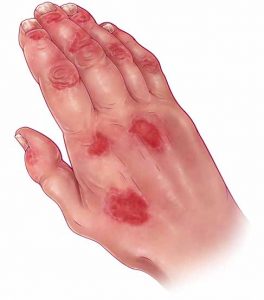 ATLANTA—As many rheumatologists will recall, it was not too long ago that psoriatic arthritis was regarded somewhat like “rheumatoid arthritis with a rash,” with little attention paid to the ways in which the unique pathophysiology and manifestations of this entity make it distinct from other forms of inflammatory arthritis. At the 2019 ACR/ARP Annual Meeting the session, Optimizing Outcomes in Psoriatic Arthritis: A Domain-Based Strategy, focused on these features of psoriatic arthritis and advocated for treating each patient as an individual—based on his or her predominant symptoms—and using objective and validated outcome measures to track progress in symptom control.
ATLANTA—As many rheumatologists will recall, it was not too long ago that psoriatic arthritis was regarded somewhat like “rheumatoid arthritis with a rash,” with little attention paid to the ways in which the unique pathophysiology and manifestations of this entity make it distinct from other forms of inflammatory arthritis. At the 2019 ACR/ARP Annual Meeting the session, Optimizing Outcomes in Psoriatic Arthritis: A Domain-Based Strategy, focused on these features of psoriatic arthritis and advocated for treating each patient as an individual—based on his or her predominant symptoms—and using objective and validated outcome measures to track progress in symptom control.
Domain-Based Outcome Measures
Elaine Husni, MD, MPH, assistant professor of medicine and vice chair of the Department of Rheumatic and Immunologic Diseases at Cleveland Clinic Lerner College of Medicine Case Western Reserve University, Cleveland, began her lecture by noting that, worldwide, 323 trials on the subject of psoriatic arthritis are currently underway, with 67 of these trials actively recruiting patients to participate. This plethora of research studies reflects how the rheumatology world has grown to better understand the pathogenesis of skin, joint, tendon and other involvement in psoriatic arthritis and how the goal of treatment is to better target these specific pathways to effectively treat symptoms and prevent damage.
Dr. Husni described two important developments in recent years: 1) outcome measures for patients have been developed to address domains that include peripheral arthritis, axial arthritis, enthesitis, dactylitis and skin involvement, and 2) such studies as the tight control of psoriatic arthritis (TICOPA) trial have demonstrated that tight control of disease activity leads to improvements in these outcome measures for patients.1
On the subject of domain-based outcome measures, Dr. Husni described some of the main measures being used in research and clinical practice. For skin involvement, the Psoriasis Area and Severity Index (PASI) is a widely used tool for the measurement of severity of psoriatic skin involvement and combines the assessment of the severity of lesions and the area affected into a single score from 0 (no disease) to 72 (maximal disease).
For peripheral arthritis, ACR20/50/70, which are composite measures of improvement of 20%, 50% and 70%, respectively, in swollen and tender joint count, patient global assessment, physician global assessment, functional ability measure, visual analog pain scale and erythrocyte sedimentation rate or C-reactive protein (CRP), are frequently used.
With respect to enthesitis, the Leeds Enthesitis Index (LEI), Spondyloarthritis Research Consortium of Canada (SPARCC) Enthesitis Index and Maastricht Ankylosing Spondylitis Enthesitis Score (MASES) can be employed to track activity. The Leeds dactylitis index is a helpful tool to evaluate and follow dactylitis in patients, and an easy-to-use tape measuring device has been developed to help clinicians easily assess the circumference of dactylitic digits.
When thinking about patients with psoriatic arthritis, go more than skin deep & truly seek to understand the disease & its manifestations.
For axial disease, the Bath Ankylosing Spondylitis Disease Activity Index (BASDAI) includes six visual analog scales used to measure the severity of fatigue, spinal and peripheral joint pain, localized tenderness and morning stiffness to measure disease activity, progression and prognosis in a reliable manner. Dr. Husni explained that it does take practice and time to develop one’s skills in examining the skin or identifying enthesitis correctly to accurately and consistently grade patients on these domain-based outcome measures. Luckily, the website of the Group for Research and Assessment of Psoriasis and Psoriatic Arthritis (GRAPPA) includes videos and training modules to teach physicians how to properly perform these assessments.2
One of the most important areas of research in psoriatic arthritis is identifying and developing the best composite measures to allow accurate tracking of disease activity and be facile enough to perform in the clinic without requiring clinicians to spend time they don’t have making such measurements. Current composite measures include the Disease Activity in Psoriatic Arthritis (DAPSA), the Composite Psoriatic Disease Activity Index (CPDAI) and the Psoriatic Arthritis Disease Activity Score (PASDAS). Each composite measure has its strengths and weaknesses; for example, the DAPSA lacks a skin component. It’s likely that composite measures created in the future will also be less than perfect in certain respects, but Dr. Husni noted that, as a field, rheumatologists should continue work in this area and think critically and creatively about how best to measure outcomes for all variations of psoriatic arthritis.
An Overview of the Literature
Philip Mease, MD, clinical professor at the University of Washington School of Medicine and director of rheumatology research at the Swedish Medical Center, Seattle, provided a masterful overview of the literature to date on the subject of treatments for psoriatic arthritis. He discussed many of the key trials and summarized recommendations from GRAPPA, the ACR and the European League Against Rheumatism (EULAR). Some of the key themes that emerged were the ideas that different pathophysiologic mechanisms may explain the different domains of psoriatic arthritis disease activity (i.e., arthritis, enthesitis, skin and nail involvement, etc.), that the role of methotrexate in the treatment of psoriatic arthritis is still a point of some debate, and that there is emerging evidence that the Janus kinase (JAK) inhibitors will likely be a helpful treatment option for many patients with psoriatic arthritis.
Perhaps most important as an overall principle, Dr. Mease noted, is that the GRAPPA clinical practice guidelines take the approach of assessing each domain of psoriatic arthritis manifestation and treating the individual patient on the basis of the most prominent domains expressed by that patient.
Dr. Mease did explain that variations in the GRAPPA, ACR and EULAR guidelines indicate there is still a paucity of data and head-to-head comparisons of medications to enable clinicians to say with confidence what the best treatment algorithm should be, but this should not stop clinicians from doing the best they can for their patients. It is the role of the field as a whole to advance the study of psoriatic arthritis.
The session was extremely helpful and lent itself to productive discourse on these important topics. The audience was left with one last piece of advice: When thinking about patients with psoriatic arthritis, go more than skin deep and truly seek to understand the disease and its manifestations.
Jason Liebowitz, MD, completed his fellowship in rheumatology at Johns Hopkins University, Baltimore, where he also earned his MD. He is currently in practice with Arthritis, Rheumatic, and Back Disease Associates, New Jersey.
References
- Coates LC, Moverley AR, McParland L, et al. Effect of tight control of inflammation in early psoriatic arthritis (TICOPA): A UK multicentre, open-label, randomised controlled trial. Lancet. 2015 Dec 19;386(10012):2489–2498.
- What’s new at GRAPPA. National Psoriasis Foundation grants and fellowships. 2019. https://www.grappanetwork.org.


